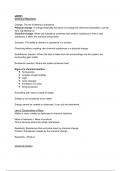w6/9/21
Chemical Reactions
Change: The act of altering a substance
Physical change: A change physically that does not change the chemical composition, just the
form. Eg Melting Ice
Chemical change: When one substance combines with another substance to form a new
substance, it alters the chemical composition.
Solvation: The ability to dissolve a substance in a solution
Dissolving without creating new chemical substances is a physical change
Endothermic reaction: Where the heat is taken from the surroundings into the system, the
surrounding gets colder
Exothermic reaction: Where the system produced heat.
Signs of a chemical reaction
❖ Temperature
❖ Creation of gas/ bubbles
❖ Light
❖ Color changes
❖ Formation of a solid
❖ Smell produced
Everything with mass is made of matter.
Energy is not considered to be matter.
Energy cannot be created or destroyed, it can only be transferred
Law of Conservation of Mass
Matter is never created or destroyed in chemical reactions
Mass of reactants = Mass of products
This is because atoms are simply rearranged
Reactants: Substances that are broke down by chemical change
Product: Substances created by the chemical change
Reactants→Product
Chemical reaction
,Iron+Oxygen becomes rust/Iron oxide
4FE(s) + 3O₂(g) → 2Fe₂O₃(s)
You must write the state of matter (gas), (solid), (liquid)
Cooking
Cooking uses heat energy, the heat energy breaks the chemical bonds of the foods and turns
them into something else, therefore it is a chemical process.
7/9/21
Reversible reactions
Chemical Type Observations Observations after Observations after
before water water heat
Anhydrous Copper Blue white powdery Thick dark blue slush, Could hear fizzing,
Sulfate substance warm, fogging up, steam, bubbling,
Temperature rises turns white, reverses
back to original
Chemical Type Observations Observations after Observations after
before heating heating adding water
Cobalt Chloride Dark pink crystal Becomes blue/dark Water turns very dark
substance magenta/pink mushy purple, there is still
substance, Gas solid inside.
escaping,
What evidence is there for a chemical reaction?
There was fizzing, heat produced, there was a colour change, the formation of a solid.
What evidence was there for the reactions being reversed?
The Anhydrous Copper Sulphate reverted from a thick dark blue slush, back to a blue/white
powder. The Cobalt Chloride changed back from a blue/dark magenta/pink mushy substance, to
a dark pink crystal substance
,9/9/21
Naming Compounds
Complex naming
Fe₂³⁺O₃²⁻= Iron (III) Oxide
Fe₂²⁺O₃²⁻= Iron (II) Oxide
Must put the charge.
Polyatomic Ions
❖ OH⁻ = Hydroxide
❖ SO₄²⁻ = Sulphate
❖ NO₃⁻ = Nitrate
❖ CO₃²⁻ = Carbonate
❖ NH₄⁺ = Ammonium
Rules of Naming Compounds
Rule 1 When two elements join, the end result usually ends in ______ide.
Rule 2 When three or more elements combine and one of them is oxygen, the ending is
_____ate.
Rule 3 If two identical elements combine then the name does not change, they always go
around in pairs.
Mono-1
Di-2
Tri-3
Tetra-4
Penta-5
Hexa-6
Hepta-7
Octa-8
Nona-9
Deca-10
Red is for the ones that will be used by the exam board
Element: A pure substance of a single element, it cannot be broken down into anything simpler,
they can exist as atoms or molecules
, Compound: Where one or more elements are chemically bonded together in a fixed ratio, its
properties differ from the elements that make it up, it can exist as atoms or molecules. It is pure
Mixtures: A substance made when elements or compounds are mixed together, they are not a
pure substance, it is not chemically bonded. The ratio of substances is not fixed and it can be
separated through physical means There are two types, Heterogeneous, They are visibly
different (Bubble Tea), and Homogeneous, it looks like one thing only (Salt Water).
When a substance is added to another substance to make a mixture, the molecules of the
substance enter the gaps between the molecules of the other mixtures. The mass changes but
the volume does not change.
There are three major groups of elements in the periodic table, Metals, Non-metals and
Metalloids
Solute (Smallest part of solution, the stuff that is being dissolved) + Solvent (Largest part of
solution, the stuff that dissolves) = Solution
10/9/21
Atomic Structure
Isotopes have different amounts of neutrons but still are the same atom.
The mass number is different.
Hydrogen has 3 isotopes
Electrons are arranged in Energy Levels or Shells around the nucleus of an atom
There are the same number of Electrons that Protons
1st Shell: 2 electrons max
2nd Shell: 8 electrons max
3st Shell: 8 electrons max
4nd Shell: 2 electrons max
Electron Representation
Dot and Cross diagrams, using dots and crosses to represent electrons and circles for rings
Electronic Configuration, electronic configuration is represented numerically
Electrons on the outermost shell are called Valence electrons
Non metals will gain electrons to form negative ions
Metals will lose electrons to form positive ions
RAM = Relative Atomic Mass
Calculating RAM




